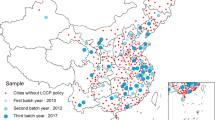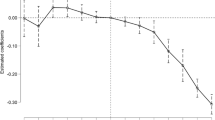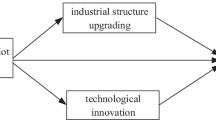Abstract
Achieving the goals of “carbon peaking” and “carbon neutrality” becomes one of the important elements of the ecological civilization strategy in China. Based on the strong balanced panel data of 281 prefecture-level cities in China from 2006 to 2019, we investigate the impact of Low-carbon city pilot policy (LCCP policy) on FDI inflows by using the multi-period DID model and intermediary model. After that, we discuss the heterogenous impact in terms of both policy tools and geographic locations. Furthermore, we investigate the spillover effects of the LCCP policy on the FDI inflows of surrounding cities using the Spatial Dubin DID model. The results show that (1) the LCCP policy can significantly attract FDI through reducing compliance costs and promoting technological innovation, and the Bacon decomposition and the placebo test show that the estimation error is small and the regression result is relatively stable; (2) command-mandatory tools have negative effects on FDI, while market-oriented tools can effectively attract FDI in pilot cities, but voluntary tools have no significant effect on FDI in pilot cities; (3) the LCCP policy can significantly promote the inflows of FDI in the eastern and western regions, but it does not significantly promote the FDI in central regions; (4) there is a positive spillover effect on FDI inflows to surrounding cities.




Similar content being viewed by others
Data availability
The data and codes presented in this study are available upon request from the corresponding author.
References
Adarkwah GK (2021), “Host government intervention and FDI inflow: an empirical investigation”, Verbeke, A., van Tulder, R., Rose, E.L. and Wei, Y. (Ed.) The multiple dimensions of institutional complexity in international business research (Progress in International Business Research, Vol. 15), Emerald Publishing Limited, Bingley, 193–218. https://doi.org/10.1108/S1745-886220210000015012
Ali S, Guo W (2005) Determinants of FDI in China. J Global Bus Technol 1(2):21–33. https://doi.org/10.1057/9781137446350_5
Anselin L, Griffith DA (1988) Do spatial effects really matter in regression analysis? Regional Science 65(1):11–34. https://doi.org/10.1111/j.1435-5597.1988.tb01155.x
Baron RM, Kenny DA (1986) The moderator–mediator variable distinction in social psychological research: conceptual, strategic, and statistical considerations. J Pers Soc Psychol 51(6):1173. https://doi.org/10.1037//0022-3514.51.6.1173
Beck T, Levine R, Levkov A (2010) Big bad banks? The winners and losers from bank deregulation in the United States. J Financ 65(5):1637–1667. https://doi.org/10.1111/j.1540-6261.2010.01589.x
Berman E, Bui LT (2001) Environmental regulation and productivity: evidence from oil refineries. Rev Econ Stat 83(3):498–510. https://doi.org/10.1162/00346530152480144
Berrone P, Fosfuri A, Gelabert L, Gomez-Mejia LR (2013) Necessity as the mother of ‘green’ inventions: institutional pressures and environmental innovations. Strateg Manag J 34(8):891–909. https://doi.org/10.1002/smj.2041
Bialek S, Weichenrieder AJ (2021) Do stringent environmental policies deter FDI? M&A versus Greenfield. Environ Resource Econ 80:603–636. https://doi.org/10.1007/s10640-021-00600-x
Bu M, Qiao Z, Liu B (2020) Voluntary environmental regulation and firm innovation in China. Econ Model 89:10–18. https://doi.org/10.1016/j.econmod.2019.12.020
Cai X, Lu Y, Wu M, Yu L (2016) Does environmental regulation drive away inbound foreign direct investment? Evidence from a quasi-natural experiment in China. J Dev Econ 123:73–85. https://doi.org/10.1016/j.jdeveco.2016.08.003
Callaway B, Sant’Anna PH (2021) Difference-in-differences with multiple time periods. J Econ 225(2):200–230. https://doi.org/10.1016/j.jeconom.2020.12.001
Chagas AL, Azzoni CR, Almeida AN (2016) A spatial difference-in-differences analysis of the impact of sugarcane production on respiratory diseases. Reg Sci Urban Econ 59:24–36. https://doi.org/10.1016/j.regsciurbeco.2016.04.002
Chen L, Wang K (2022) The spatial spillover effect of low-carbon city pilot scheme on green efficiency in China’s cities: evidence from a quasi-natural experiment. Energy Economics 110:106018. https://doi.org/10.1016/j.eneco.2022.106018
Cheng LK, Kwan YK (2000) What are the determinants of the location of foreign direct investment? The Chinese experience. J Int Econ 51(2):379–400. https://doi.org/10.1016/S0022-1996(99)00032-X
Cheng J, Yi J, Dai S, Xiong Y (2019) Can low-carbon city construction facilitate green growth? Evidence from China’s pilot low-carbon city initiative. J Clean Prod 231:1158–1170. https://doi.org/10.1016/j.jclepro.2019.05.327
Copeland BR, Taylor MS (2004) Trade, growth, and the environment. J Econ Lit 42(1):7–71. https://doi.org/10.1257/002205104773558047
Cui J, Zhang J, Zheng Y (2018) Carbon pricing induces innovation: evidence from China’s regional carbon market pilots. In AEA Papers Proc 108:453–457. https://doi.org/10.1257/pandp.20181027
Dean JM, Lovely ME, Wang H (2009) Are foreign investors attracted to weak environmental regulations? Evaluating the evidence from China. J Dev Econ 90(1):1–13. https://doi.org/10.1016/j.jdeveco.2008.11.007
Du J, Lu Y, Tao Z (2008) Economic institutions and FDI location choice: evidence from US multinationals in China. J Comp Econ 36(3):412–429. https://doi.org/10.1016/j.jce.2008.04.004
Ekholm K, Forslid R, Markusen JR (2007) Export-platform foreign direct investment. J Eur Econ Assoc 5(4):776–795. https://doi.org/10.1162/JEEA.2007.5.4.776
Fahad S, Bai D, Liu L, Baloch ZA (2022) Heterogeneous impacts of environmental regulation on foreign direct investment: do environmental regulation affect FDI decisions? Environ Sci Pollut Res 29(4):5092–5104. https://doi.org/10.1007/s11356-021-15277-4
Gehrsitz M (2017) The effect of low emission zones on air pollution and infant health. J Environ Econ Manag 83:121–144. https://doi.org/10.1016/j.jeem.2017.02.003
Goodman-Bacon A (2021) Difference-in-differences with variation in treatment timing. J Econ 225(2):254–277. https://doi.org/10.1016/j.jeconom.2021.03.014
Huang Y, Liao C, Zhang J, Guo H, Zhou N, Zhao D (2019) Exploring potential pathways towards urban greenhouse gas peaks: a case study of Guangzhou China. Applied Energy 251:113369. https://doi.org/10.1016/j.apenergy.2019.113369
Huo W, Qi J, Yang T, Liu J, Liu M, Zhou Z (2022) Effects of China’s pilot low-carbon city policy on carbon emission reduction: a quasi-natural experiment based on satellite data. Technol Forecast Social Change 175:121422. https://doi.org/10.1016/j.techfore.2021.121422
Khanna N, Fridley D, Hong L (2014) China’s pilot low-carbon city initiative: a comparative assessment of national goals and local plans. Sustain Cities Soc 12:110–121. https://doi.org/10.1016/j.scs.2014.03.005
Kim Y, Rhee DE (2019) Do stringent environmental regulations attract foreign direct investment in developing countries? Evidence on the “Race to the Top” from cross-country panel data. Emerg Mark Financ Trade 55(12):2796–2808. https://doi.org/10.1080/1540496X.2018.1531240
Kukenova M, Monteiro JA (2008). Does lax environmental regulation attract FDI when accounting for ‘Third-Country’ effects?. Available at SSRN 1292705. https://ssrn.com/abstract=1292705 or https://doi.org/10.2139/ssrn.1292705
Li H, Wang J, Yang X, Wang Y, Wu T (2018) A holistic overview of the progress of China’s low-carbon city pilots. Sustain Cities Soc 42:289–300. https://doi.org/10.1016/j.scs.2018.07.019
Li J, Li F, Li J (2022) Does new-type urbanization help reduce haze pollution damage? Evidence from China’s county-level panel data. Environ Sci Pollut Res 29:47123–47136. https://doi.org/10.1007/s11356-022-19272-1
Lin L, Sun W (2016) Location choice of FDI firms and environmental regulation reforms in China. J Regul Econ 50(2):207–232. https://doi.org/10.1007/s11149-016-9303-9
List JA, Co CY (2000) The effects of environmental regulations on foreign direct investment. J Environ Econ Manag 40(1):1–20. https://doi.org/10.1006/jeem.1999.1095
Liu F, Liu C (2019) Regional disparity, spatial spillover effects of urbanization and carbon emissions in China. J Clean Prod 241:118226. https://doi.org/10.1016/j.jclepro.2019.118226
Liu W, Qin B (2016) Low-carbon city initiatives in China: a review from the policy paradigm perspective. Cities 51:131–138. https://doi.org/10.1016/j.cities.2015.11.010
Liu C, Zhou Z, Liu Q, Xie R, Zeng X (2020) Can a low-carbon development path achieve win-win development: evidence from China’s low-carbon pilot policy. Mitig Adapt Strat Glob Change 25(7):1199–1219. https://doi.org/10.1007/s11027-019-09897-y
Mani M, Wheeler D (1998) In search of pollution havens? Dirty industry in the world economy, 1960 to 1995. J Environ Dev 7:215–247. https://doi.org/10.1177/107049659800700302
Menguc B, Auh S, Ozanne L (2010) The interactive effect of internal and external factors on a proactive environmental strategy and its influence on a firm’s performance. J Bus Ethics 94(2):279–298. https://doi.org/10.1007/s10551-009-0264-0
Noorbakhsh F, Paloni A, Youssef A (2001) Human capital and FDI inflows to developing countries: new empirical evidence. World Dev 29(9):1593–1610. https://doi.org/10.1016/S0305-750X(01)00054-7
Porter ME (1990) The Competitive Advantage of Nations. Free Press-Macmillan, New York
Porter ME (1991) ‘America’s green strategy. Sci Am 264:168. https://doi.org/10.1038/scientificamerican0491-168
Porter ME, van der Linde C (1995a) Green and competitive: ending the stalemate. Harv Bus Rev 73(5):120–134
Porter ME, van der Linde C (1995b) Toward a new conception of the environment – competitiveness relationship. J Econ Perspect 9(4):97–118. https://doi.org/10.1257/jep.9.4.97
Qiu S, Wang Z, Liu S (2021) The policy outcomes of low-carbon city construction on urban green development: evidence from a quasi-natural experiment conducted in China. Sustain Cities Soc 66:102699. https://doi.org/10.1016/j.scs.2020.102699
Qu Y, Liu Y (2017) Evaluating the low-carbon development of urban China. Environ Dev Sustain 19(3):939–953. https://doi.org/10.1007/s10668-016-9777-8
Rezza AA (2015) A meta-analysis of FDI and environmental regulations. Environ Dev Econ 20(2):185–208. https://doi.org/10.1017/s1355770x14000114
Riedl A (2010) Location factors of FDI and the growing services economy: evidence for transition countries. Econ Transit 18(4):741–761. https://doi.org/10.1111/j.1468-0351.2010.00391.x
Rubashkina Y, Galeotti M, Verdolini E (2015) Environmental regulation and competitiveness: empirical evidence on the Porter Hypothesis from European manufacturing sectors. Energy Policy 83:288–300. https://doi.org/10.1016/j.enpol.2015.02.014
Shi X, Xu Z (2018) Environmental regulation and firm exports: evidence from the eleventh Five-Year Plan in China. J Environ Econ Manag 89:187–200. https://doi.org/10.1016/j.jeem.2018.03.003
Shin K (2018) Environmental policy innovations in China: a critical analysis from a low-carbon city. Environmental Politics 27(5):830–851. https://doi.org/10.1080/09644016.2018.1449573
Su M, Zheng Y, Yin X, Zhang M, Wei X, Chang X, Qin Y (2016) Practice of low-carbon city in China: the status quo and prospect. Energy Procedia 88:44–51. https://doi.org/10.1016/j.egypro.2016.06.014
Sun L, Abraham S (2021) Estimating dynamic treatment effects in event studies with heterogeneous treatment effects. J Econ 225(2):175–199. https://doi.org/10.1016/j.jeconom.2020.09.006
Sun Q, Tong W, Yu Q (2002) Determinants of foreign direct investment across China. J Int Money Financ 21(1):79–113. https://doi.org/10.1016/S0261-5606(01)00032-8
Tang P, Zeng H, Fu S (2019) Local government responses to catalyse sustainable development: learning from low-carbon pilot programme in China. Sci Total Environ 689:1054–1065. https://doi.org/10.1016/j.scitotenv.2019.06.375
Tian Y, Feng C (2022) The internal-structural effects of different types of environmental regulations on China’s green total-factor productivity. Energy Economics 113:106246. https://doi.org/10.1016/j.eneco.2022.106246
Walter I, Ugelow JL (1979). Environmental policies in developing countries. Ambio 102–109. https://www.jstor.org/stable/4312437
Wang Y, Li J (2019) Spatial spillover effect of non-fossil fuel power generation on carbon dioxide emissions across China’s provinces. Renewable Energy 136:317–330. https://doi.org/10.1016/j.renene.2019.01.012
Wang Y, Song Q, He J, Qi Y (2015) Developing low-carbon cities through pilots. Climate Policy 15(sup1):S81–S103. https://doi.org/10.1080/14693062.2015.1050347
Wang Z, Dou X, Wu P, Liang S, Cai B, Cao L et al (2020) Who is a good neighbor? Analysis of frontrunner cities with comparative advantages in low-carbon development. J Environ Manag 269:110804. https://doi.org/10.1016/j.jenvman.2020.110804
Xing Y, Kolstad CD (2002) Do lax environmental regulations attract foreign investment? Environ Resource Econ 21(1):1–22. https://doi.org/10.1023/A:1014537013353
Yao Y, Shen X (2021) Environmental protection and economic efficiency of low-carbon pilot cities in China. Environ Dev Sustain 23(12):18143–18166. https://doi.org/10.1007/s10668-021-01431-y
Yoon H, Heshmati A (2021) Do environmental regulations affect FDI decisions? The pollution haven hypothesis revisited. Sci Public Policy 48(1):122–131. https://doi.org/10.1093/scipol/scaa060
Yu X, Li Y (2020) Effect of environmental regulation policy tools on the quality of foreign direct investment: an empirical study of China. J Clean Prod 270:122346. https://doi.org/10.1016/j.jclepro.2020.122346
Yu CH, Wu X, Zhang D, Chen S, Zhao J (2021) Demand for green finance: resolving financing constraints on green innovation in China. Energy Policy 153:112255. https://doi.org/10.1016/j.enpol.2021.112255
Zhang KH (2001) China’s inward FDI boom and the greater Chinese economy. Chinese Economy 34(1):74–88. https://doi.org/10.2753/CES1097-1475340174
Zhang J, Fu X (2008) FDI and environmental regulations in China. J Asia Pacific Econ 13(3):332–353. https://doi.org/10.1080/13547860802131326
Zhang B, Wang Z, Lai KH (2015) Mediating effect of managers’ environmental concern: Bridge between external pressures and firms’ practices of energy conservation in China. J Environ Psychol 43:203–215. https://doi.org/10.1016/j.jenvp.2015.07.002
Zhang B, Chen X, Guo H (2018) Does central supervision enhance local environmental enforcement? Quasi-experimental evidence from China. J Public Econ 164:70–90. https://doi.org/10.1016/j.jpubeco.2018.05.009
Zhao C, Wang B (2021) Does China’s low-carbon pilot policy promote foreign direct investment? An empirical study based on city-level panel data of China. Sustainability 13(19):10848. https://doi.org/10.3390/su131910848
Zheng J, Shao X, Liu W, Kong J, Zuo G (2021) The impact of the pilot program on industrial structure upgrading in low-carbon cities. J Clean Prod 290:125868. https://doi.org/10.1016/j.jclepro.2021.125868
Zhou X, Zhao X (2022) Does diversified environmental regulation make FDI cleaner and more beneficial to China’s green growth? Environ Sci Pollut Res 29(3):3487–3497. https://doi.org/10.1007/s11356-021-15937-5
Acknowledgements
We are grateful to the reviewers for their insightful comments and careful review.
Funding
This research was funded by Guangdong Science and Technology Department under Grant (2019A101002064), Innovation Team in Guangdong Higher Education under Grant (2021WCXTD010), and Natural Science Foundation of Guangdong under grant (2021A1515011880).
Author information
Authors and Affiliations
Contributions
Su Pan: writing—review and editing, supervision, investigation. Xujing Lu: writing—original draft, methodology, formal analysis. Ying Chai: supervision, review. Dan Huang and Yutong Cai: data collection and collating. All authors read and approved the final manuscript.
Corresponding author
Ethics declarations
Ethical approval
Not applicable.
Consent to participate
Not applicable.
Consent for publication
Not applicable.
Competing interests
The authors declare no competing interests.
Additional information
Responsible Editor: Ilhan Ozturk
Publisher's note
Springer Nature remains neutral with regard to jurisdictional claims in published maps and institutional affiliations.
Rights and permissions
Springer Nature or its licensor (e.g. a society or other partner) holds exclusive rights to this article under a publishing agreement with the author(s) or other rightsholder(s); author self-archiving of the accepted manuscript version of this article is solely governed by the terms of such publishing agreement and applicable law.
About this article
Cite this article
Pan, S., Lu, X., Chai, Y. et al. Low carbon city and FDI inflows: evidence from China. Environ Sci Pollut Res 31, 10198–10212 (2024). https://doi.org/10.1007/s11356-023-27902-5
Received:
Accepted:
Published:
Issue Date:
DOI: https://doi.org/10.1007/s11356-023-27902-5




